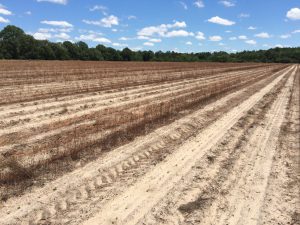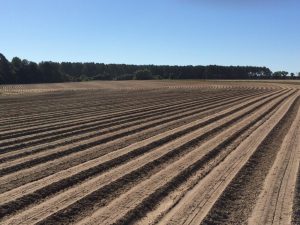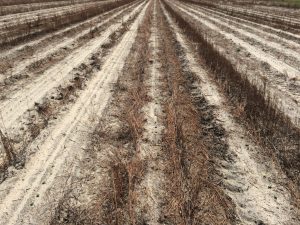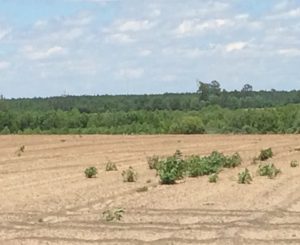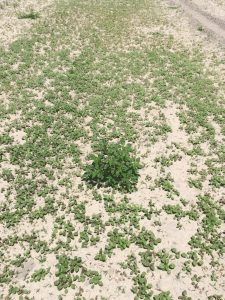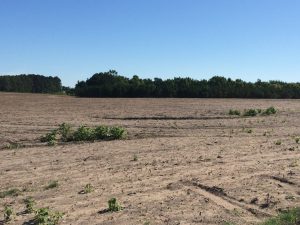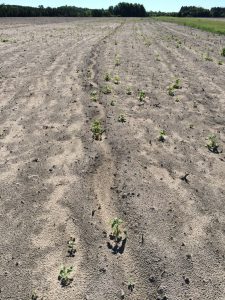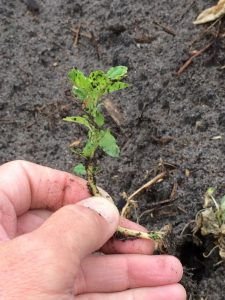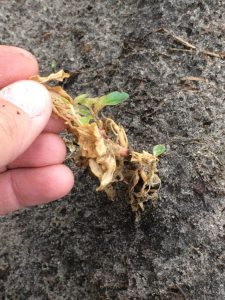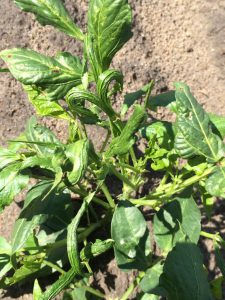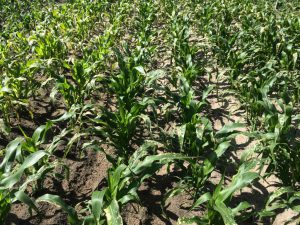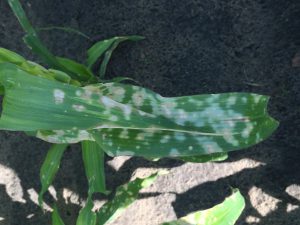In 2005, the first pigweed resistant to glyphosate (Roundup) was confirmed in middle Georgia. At that time, it was the first confirmed case of pigweed resistant to glyphosate in the world. The resistance was localized to a few fields on about 500 acres. Within a few years it was in nearly every row crop field in the state.
The chemicals (in this case glyphosate) being used didn’t cause the pigweed to change, rather it was the genetic diversity within the species allowing a few plants to tolerate glyphosate. The plants that were resistant survived and reproduced seed. As most understand, one female pigweed can produce approximately 500,000 seed per plant when competing with cotton for an entire season. If all those seeds produce plants the next year and then each of those plants produce the same amount of seed (500,000X500,000 = 250,000,000,000; 500,000X500,000X500,000 is 125,000,000,000,000,000) that’s 125 quadrillion seed in three seasons. Granted, that’s assuming all the seeds germinating produce female plants, which they don’t, but you can easily see how quickly the population increases.
Palmer amaranth with resistance to glyphosate spreads rapidly across the landscape often overwhelming a field in just three years. Managing the seed bank prior to planting has been discussed now for multiple seasons. One of the critical steps UGA Extension has stated over and over is to start clean in a field prior to planting. If the pigweed never comes up then you don’t have to deal with it.
There are many fields with very successful weed control programs:
While there are a lot of clean fields with an excellent herbicide program, I’ve seen plenty of pigweeds alive and well in other fields. After nearly 12 years of fighting resistant pigweed and learning how to manage it, there are still fields being bedded and planted into with emerged pigweed. Research has proven that the biggest yield lost to pigweed (and most any weed) occurs within the first three weeks after planting. Starting clean is the key to having a successful herbicide program. In some cases, the field that’s being planted has pigweed that is already too large for a herbicide to control. My guess is in these situations someone will try to overuse the newer herbicide technologies. If this starts to happen……… go back and reread the first three paragraphs to find out what will happen. Let’s hope history doesn’t repeat itself, but it will if we don’t make intelligent decisions.
In the Southeast Farm Press there’s an article by Forrest Laws titled, “Getting off resistance treadmill.” In that article University of Arkansas Weed Scientist, Bob Scott, discussed their demonstrations of how quickly pigweed can develop resistance to dicamba. He says, “We proved this in a lab where this particular population of pigweed in just three selections using sub-lethal doses was not controlled with 16 ounces of dicamba. So we just proved it can happen if we’re not proactive in managing this from day one.”
I think it’s also important to remember that previous research has proven that just 2 pigweed plants per 20 feet of row = 23% Yield Loss.
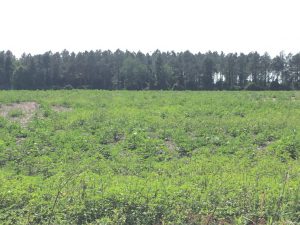
The fields I’ve looked at this year with a major weed problem have the same things in common: they’re harrowed and then bedded.

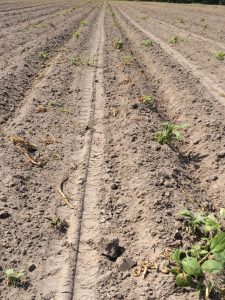
Remember: whether you’re spraying or harrowing to control pigweed, the size of the weed is critical. You can’t kill a large pigweed with one pass of a disk and bedding pigweed doesn’t kill them either. In fact, I’m almost to the point where I just want to tell growers we can’t control pigweed very well with a disk alone. Unless a person is willing to be in a field and disk multiple times (weekly, or every few weeks), the field will not be clean at planting.
With no residual herbicide seeds germinate quickly after disking and this is what needs to be avoided:
Below are pigweed with regrowth 2 weeks after being bedded and then sprayed with paraquat:
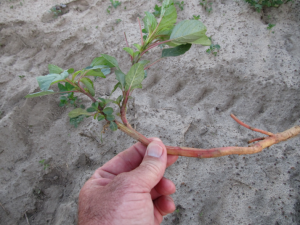
What’s the solution? Use a pre emergent herbicide. Whether it’s cotton or peanut (what most of our acres are in this county) being planted, disk the field and then put a herbicide out. Products like valor give nearly 30 days of residual control.
For peanut land Valor can be applied prior to planting and there’s no waiting period. There are also other pre-emergent herbicides available depending on the crop grown.
For cotton, on strip till land Valor can be applied 10 days ahead of planting as long as strip till operation (including a ripper shank) occurs between applying Valor and planting
For no till or when the strip is run prior to spraying you’ll need 21 to 28 days (28 days following a disk because no residue) between application and planting and add 7 more days if using reflex.
If you are planting cotton conventionally, consider the split reflex system. The split reflex system works real well, especially in dryland fields. Incorporate 12 oz Reflex + yellow herbicide in moist soil then put another 8 to 10 oz of Reflex with Warrant or Direx behind planting and you are off to a great start. Stay timely with POST applications.
In irrigated fields turn the pivot on after applying pre herbicides to get them activated if there’s no rainfall. Irrigating is expensive, but multiple trips through a field with a disk and having to hand weed later on are expensive too.
A few years ago there was an article in a popular farm magazine and one of the farmers interviewed stated; “We’ll actually put out herbicide before we do any tillage, because you can’t rely on tillage alone to eliminate that problem. Disking, bedding or chiseling alone won’t do the job. You have to kill pigweed before it gets above the ground.”
As one University weed scientist said; “You have to be careful. If you don’t do a thorough job of disking, you can end up with a worse problem than when you started.”
You have to kill pigweed before it gets above the ground.
If you have a field that started out with weed problems, stay timely with post applications and hand weed escapes.
I’ll end this post with the below pictures. Most of you reading this knows exactly what caused it. Be aware of what’s around your fields when making herbicide applications. Drift complaints have started.
